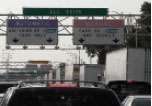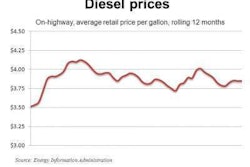CVSA touts improved Operation Safe Driver results
Annual campaign targets both commercial, passenger drivers
The Commercial Vehicle Safety Alliance said the results from its 2011 Operation Safe Driver campaign show that targeting enforcement and education efforts at both passenger as well as commercial vehicle drivers is starting to pay off. Drivers are slowing down and taking heed of safety groups’ messages that driving fast and cutting it close around commercial vehicles is a deadly combination.
 Operation Safe Driver was launched to improve the behavior of all drivers operating in an unsafe manner by, in or around commercial vehicles.
Operation Safe Driver was launched to improve the behavior of all drivers operating in an unsafe manner by, in or around commercial vehicles.Operation Safe Driver was launched in 2007 by CVSA in partnership with the Federal Motor Carrier Safety Administration to address the problem of improving the behavior of all drivers operating in an unsafe manner – either by, in or around commercial vehicles – and to initiate educational and enforcement strategies to address those exhibiting high-risk behaviors.
“Campaigns that target and remove unsafe drivers from the road, like CVSA’s Operation Safe Driver, are yielding positive results,” said Stephen Keppler, CVSA’s executive director. “Until we move closer to achieving zero deaths, CVSA will continue to educate the driving public – and especially teens – about the risks they take when speeding and cutting off vehicles.”
CVSA initiated two new focus areas under the Operation Safe Driver campaign: The Teens & Trucks Program and the Defeating Distracted Driving campaign. During this year’s Operation Safe Driver campaign, law enforcement officers who pulled over nearly 44,000 commercial and passenger vehicle drivers found that the top three reasons warnings and citations were issued included speeding, failure to obey traffic control devices and failing to use a safety belt.
Of the warnings issued to CMV drivers, 16.8 percent were for speeding, versus 40.5 percent for passenger car drivers, both significant reductions from 2010; 5.9 percent were for failure to obey traffic control devices, compared to 3.2 percent for passenger car drivers, minor reductions from 2010; and 3 percent were issued for failing to use a seatbelt while operating their vehicle, compared to 1.9 percent for passenger car counterparts. These numbers represent a slight rise for CMV drivers and a slight decrease for passenger car drivers.
Of the citations issued to CMV drivers, 12.8 percent were for speeding, versus 40.6 percent – a significant drop for passenger car drivers; 2.9 percent were for failure to obey traffic control devices, a slight drop, compared to 1.9 percent for passenger car drivers; and 3.7 percent were issued for failing to use a seatbelt while operating their vehicle, compared to 7.0 percent for passenger car counterparts. CMV drivers were issued significantly less warnings and citations in 2011 for failing to buckle up (416) as compared to 2010 (1,055).
The data, obtained during the fourth annual Operation Safe Driver campaign conducted Oct. 15-22, 2011, was collected by 3,805 law enforcement personnel at 1,848 locations across the United States and Canada.
“FMCSA is proud to be part of a lifesaving effort like Operation Safe Driver – which sends a strong message to all drivers to think safety first, every trip and every time,” said FMCSA Administrator Anne Ferro.
NPTC backs Unified Registration System
While generally supporting the Federal Motor Carrier Safety Administration’s efforts to make the Unified Registration System more efficient, the National Private Truck Council said the agency’s proposal to require private fleets to demonstrate hazardous materials insurance coverage is redundant and unnecessary.
NPTC’s comments were filed last month in response to FMCSA’s Supplemental Notice of Proposed Rulemaking on the Unified Registration System. The FMCSA proposal is intended to streamline the existing registration process so that the agency can better track motor carriers, freight forwarders, brokers, intermodal equipment providers and cargo tank facilities.
NPTC said it frequently has advised FMCSA officials that the agency’s primary registration system, the Motor Carrier Management Information System, is out of date and contains far too many entities that have long since ceased operating. “The URS is a new opportunity to ensure that the FMCSA captures all of the existing carriers and intermediaries in a useable database and also purges those entries that are no longer relevant,” NPTC said in its comments.
NPTC supported inclusion of both private and for-hire motor carriers in the new URS database. “Both private and for-hire carriers are subject to the Federal Motor Carrier Safety Regulations to the same extent, and there is no policy reason for separating entries for private truck fleets,” NPTC said. “Moreover, many private fleets also have for-hire operating authority to supplement their private carrier operations, which further blurs the regulatory distinction between private and for-hire carriers for safety purposes.”
IN BRIEF 2/12
Donald J. Schneider, chairman emeritus and former president and CEO of Green Bay, Wis.-based Schneider National, died Jan. 13 following a battle with Alzheimer’s disease; he was 76. Schneider retired from day-to-day responsibilities in 2002, selecting then-chief operating officer Chris Lofgren to succeed him as president and CEO. Schneider retired in 2007.
The U.S. Department of Transportation announced nearly $1.6 billion to states and territories across the nation to help cover the costs of repairing roads and bridges damaged by natural disasters.
James H. Wood, 45, former supervisor of the Federal Motor Carrier Safety Administration’s office in Buffalo, N.Y., was sentenced in federal court to 18 months in prison for accepting bribes from third parties working for Canadian trucking companies.
J.J. Keller and Associates Inc. announced that James J. Keller, president and chief operating officer, succeeded his brother, Robert L. Keller, as president and chief executive officer effective Jan. 1. Robert Keller will remain as chairman.
The finalists for the 2011 Company Driver of the Year award are James Coles of MacKinnon Transport, John Moeller of Roehl Transport and Ronald Round of Pottle’s Transportation. The finalists for the 2011 Owner-Operator of the Year award are Kirby Killgore of O & S Trucking, Larry Severson of Dart Transit and Bryan Smith of Art Pape Transfer. The winners of the contests – sponsored by the Truckload Carriers Association and Randall-Reilly Business Media & Information Co. – will be announced at TCA’s annual convention March 4-7 at the Gaylord Palms in Kissimmee, Fla.
The 2012 Charlotte Diesel Super Show will be held Friday and Saturday, Oct. 5-6, at the zMax Dragway/Charlotte Motor Speedway Complex in Concord, N.C. Tickets will go on sale in March. For more information, contact the Randall-Reilly Events Group at [email protected] or go to www.dieselsupershow.com.
NBB backs EPA’s renewable fuels requirements
The National Biodiesel Board expressed support for the U.S. Environmental Protection Agency’s final rule establishing U.S. renewable fuel requirements for 2012 and called on the Obama administration to act quickly in completing a 2013 rule that maintains EPA’s recommended volume increases for biomass-based diesel.
The 2012 rule raises the biomass-based diesel program to 1 billion gallons, up from 800 million gallons this year. According to EPA, the biodiesel industry had produced some 908 million gallons through the end of November 2011, exceeding the annual requirement with one month of production remaining.
 The U.S. Environmental Protection Agency’s final rule establishing U.S. renewable fuel requirements raises the biomass-based diesel program to 1 billion gallons, up from 800 million gallons this year.
The U.S. Environmental Protection Agency’s final rule establishing U.S. renewable fuel requirements raises the biomass-based diesel program to 1 billion gallons, up from 800 million gallons this year.“This industry has shown without a doubt that it can meet and exceed the goals of this program in a sustainable way with a diverse mix of feedstocks,” said Anne Steckel, vice president of federal affairs at NBB, the trade association for the U.S. biodiesel industry. “Our industry has plants in nearly every state in the country that are hiring new employees and ramping up production, in part because of the demand that this policy creates.”
Steckel also urged the administration to issue a final rule for 2013 volumes raising the biomass-based diesel requirement to 1.28 billion gallons, as EPA proposed earlier this year. On Dec. 27, EPA postponed finalizing the 2013 volume, saying it needs more time for review.
“We would have preferred to see that number released and hope to see it finalized soon so that our member companies can plan their investments and continue boosting this economy,” Steckel said. “The increase will create thousands of jobs, improve our energy security by diversifying the fuel supply and cut down on pollution and greenhouse gas emissions.”
Bill would toughen toll hike criteria
The American Trucking Associations thanked Rep. Michael Grimm (R-N.Y.) and Sen. Frank Lautenberg (D-N.J.) after the legislators introduced a bill aimed at preventing unjustified toll increases. The legislation would let the U.S. Department of Transportation determine if toll increases are “just and reasonable,” a power the agency had until 1987, and allow DOT to override what it deems excessive and unjustified increases.
 The legislation would let DOT determine if toll increases are ‘just and reasonable.’
The legislation would let DOT determine if toll increases are ‘just and reasonable.’Last year, over the objections of ATA and other groups, the Port Authority of New York and New Jersey oversaw a package of toll hikes in order to balance its own budget and pay for a number of nontransportation costs. “There are a number of reasons why tolling is bad public policy, but that policy gets worse when the tolls are raised without consideration for the users of highways and bridges and the revenue generated is not dedicated for their benefit, but rather stolen for other projects,” said Bill Graves, ATA president and CEO.
New coalition unites industry leaders for EV development
Executives from companies in the transportation and utility industries on Jan. 6 announced a new coalition to design a large-scale electric vehicle demonstration project to help create a comprehensive national model for EV deployment. The Electrification Leadership Council is a coalition of key stakeholders throughout the EV supply chain who tout the expertise and resources required to engage federal, state, regional and local agencies and coalitions, utility companies, vehicle manufacturers and financial institutions to help overcome the barriers to broad-scale EV deployment.
 The Electrification Leadership Council wants to design a large-scale electric vehicle demonstration project to help create a comprehensive national model for EV deployment.
The Electrification Leadership Council wants to design a large-scale electric vehicle demonstration project to help create a comprehensive national model for EV deployment.ELC members include FedEx Express, Hertz, Navistar, Azure Dynamics, A123 Systems, Coda Automotive, Pacific Gas and Electric Co., ECOtality, Automatiks and GE Capital, among other members, along with representatives from national, state and local agencies. “Our council recognizes that no one entity can create a comprehensive solution for the broad-scale deployment of EVs,” said Mark Aubry, vice president of Navistar’s eStar electric vehicle brand. “That’s why we have come together to create a public and private model that will help us understand what will be required to operate thousands of EVs within a community.”
The ELC’s strategy also leverages the work of other prominent national organizations such as the Electrification Coalition and the Electric Drive Transportation Association that are promoting public policies and education to facilitate the deployment of EVs. Its initial task is to design its demonstration project that will focus on a large-scale EV deployment within densely populated local markets where all of the components of an EV ecosystem can be brought together to better understand the interoperability between EVs and the electric grid across a variety of vehicle classes and applications. Ecosystem components include everything from EV deployment, charging stations, the electrical grid, energy storage devices and battery second-life applications to communication systems and support networks.
“This is about developing a more efficient, effective and environmentally friendly EV ecosystem,” said Dennis Beal, vice president of global vehicles for FedEx Express. “We work with many companies across the EV ecosystem, have learned a lot and are hungry to share our learning, expand collaboration and further the future of transportation electrification with this large-scale cross-industry project. It is the responsible thing to do across the board – environmentally, economically and for our national security as we reduce our dependence on foreign oil and move toward environmentally friendly technologies.”
The ELC will engage with communities that already have developed collaborative efforts to foster EV readiness related to infrastructure planning, regulatory alignment and public awareness and will help those communities close their EV readiness gaps at the grassroots level by addressing barriers to EV deployment.











